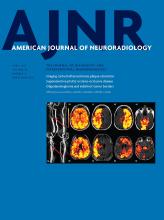Research ArticleSpine Imaging and Spine Image-Guided Interventions
Diagnostic Quality of 3D T2-SPACE Compared with T2-FSE in the Evaluation of Cervical Spine MRI Anatomy
F.H. Chokshi, G. Sadigh, W. Carpenter and J.W. Allen
American Journal of Neuroradiology April 2017, 38 (4) 846-850; DOI: https://doi.org/10.3174/ajnr.A5080
F.H. Chokshi
aFrom the Department of Radiology and Imaging Sciences, Division of Neuroradiology (F.H.C., G.S., J.W.A.)
bDepartment of Biomedical Informatics (F.H.C.)
G. Sadigh
aFrom the Department of Radiology and Imaging Sciences, Division of Neuroradiology (F.H.C., G.S., J.W.A.)
W. Carpenter
cDepartment of Radiology and Imaging Sciences, Division of Musculoskeletal Radiology (W.C.)
J.W. Allen
aFrom the Department of Radiology and Imaging Sciences, Division of Neuroradiology (F.H.C., G.S., J.W.A.)
dDepartment of Neurology (J.W.A.), Emory University School of Medicine, Atlanta, Georgia.

REFERENCES
- 1.↵
- 2.↵
- Senova S,
- Hosomi K,
- Gurruchaga JM, et al
- 3.↵
- 4.↵
- Czerny C,
- Trattnig S,
- Baumgartner WD, et al
- 5.↵
- 6.↵
- 7.↵
- 8.↵
- Meindl T,
- Wirth S,
- Weckbach S, et al
- 9.↵
- Obuchowski NA,
- Gazelle GS
- Obuchowski NA
- 10.↵
- Viera AJ,
- Garrett JM
- 11.↵
- 12.↵
- Chokshi FH,
- Tu RK,
- Nicola GN, et al
- 13.↵
- 14.↵
- 15.↵
- Stafira JS,
- Sonnad JR,
- Yuh WT, et al
- 16.↵
- 17.↵
- 18.↵
- 19.↵
- 20.↵
- 21.↵
In this issue
American Journal of Neuroradiology
Vol. 38, Issue 4
1 Apr 2017
Advertisement
F.H. Chokshi, G. Sadigh, W. Carpenter, J.W. Allen
Diagnostic Quality of 3D T2-SPACE Compared with T2-FSE in the Evaluation of Cervical Spine MRI Anatomy
American Journal of Neuroradiology Apr 2017, 38 (4) 846-850; DOI: 10.3174/ajnr.A5080
0 Responses
Jump to section
Related Articles
- No related articles found.
Cited By...
This article has not yet been cited by articles in journals that are participating in Crossref Cited-by Linking.
More in this TOC Section
Similar Articles
Advertisement











